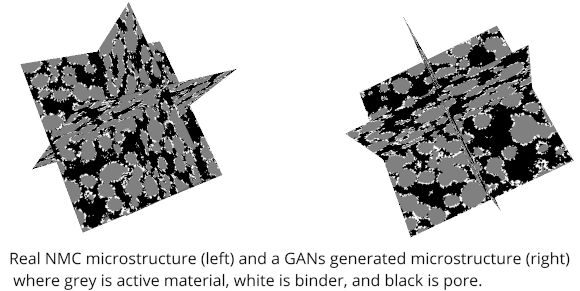Machine learning is being rapidly implemented on a wide variety of problems in the energy sciences due to the ease with which it is able to represent the kind of highly complex, multidimensional, non-linear problems characteristic of electrochemistry. In the ESE group, machine learning methods are being applied to image analysis (such as classification of phases), microstructural generation, cell lifetime prediction, and grid demand forecasting. High quality and abundant data is typically necessary for these problems, which is well catered for by the ESE group’s depth experimental research.
As part of the ESE group, Sam’s group at Dyson School of Design Engineering is leading this topic of research. Sam’s group principally focuses on the use of simulations and machine learning methods to characterise and design materials for energy storage and conversion applications. This includes the collection and analysis of 3D images, isotopic labelling data and impedance spectra, as well as a variety of other experimental techniques. These methods have been applied to a wide range of technologies, including lithium-ion batteries, fuel cells and supercapacitors.
Current projects
Recent publications, 2020 - to date
Dahari, A., Kench, S., Squires, I., & Cooper, S. J. (2022). Fusion of Complementary 2D and 3D Mesostructural Datasets Using Generative Adversarial Networks. Advanced Energy Materials, 2202407.
Finegan, D. P., Squires, I., Dahari, A., Kench, S., Jungjohann, K. L., & Cooper, S. J. (2022). Machine-Learning-Driven Advanced Characterization of Battery Electrodes. ACS Energy Letters, 7, 4368-4378.
Kench, S., Squires, I., Dahari, A., & Cooper, S. J. (2022). MicroLib: A library of 3D microstructures generated from 2D micrographs using SliceGAN. Scientific data, 9(1), 1-8.
Ruan H, Chen J, Ai W, W B, 2022, Generalised diagnostic framework for rapid battery degradation quantification with deep learning
Mistry A, Franco AA, Cooper SJ, Roberts SA, and Viswanathan V, 2021, How Machine Learning Will Revolutionize Electrochemical Sciences, ACS Energy Lett., Vol: 16, Pages: 1422–1431
Gayon-Lombardo A, Mosser L, Brandon NP, Cooper S, 2020, Pores for thought: Generative adversarial networks for stochastic reconstruction of 3D multi-phase electrode microstructures with periodic boundaries, npj Computational Materials, Vol: 6, Pages: 1-11
The microstructural database generated using machine learning from 2D materials images: Microlib
Link to Microlib
.gif)
Dramatic pores
Characterisation and design of battery electrode microstructures using simulation and machine learning
Invited talk ARTISTIC conference, July 1, 2020
Check out the new publication: Pores for thought

 Recent work has focussed on generative adversarial nets (GANs), which are used to synthesise visually indistinguishable images compared to a training dataset. Given an electrode micrograph, this allows the generation of large volumes of realistic electrode microstructure. An extension of this concept allows the synthesis of periodic microstructures, which is useful in the context of electrochemical simulation where periodic boundary conditions reduce the required sample volume.
Recent work has focussed on generative adversarial nets (GANs), which are used to synthesise visually indistinguishable images compared to a training dataset. Given an electrode micrograph, this allows the generation of large volumes of realistic electrode microstructure. An extension of this concept allows the synthesis of periodic microstructures, which is useful in the context of electrochemical simulation where periodic boundary conditions reduce the required sample volume.